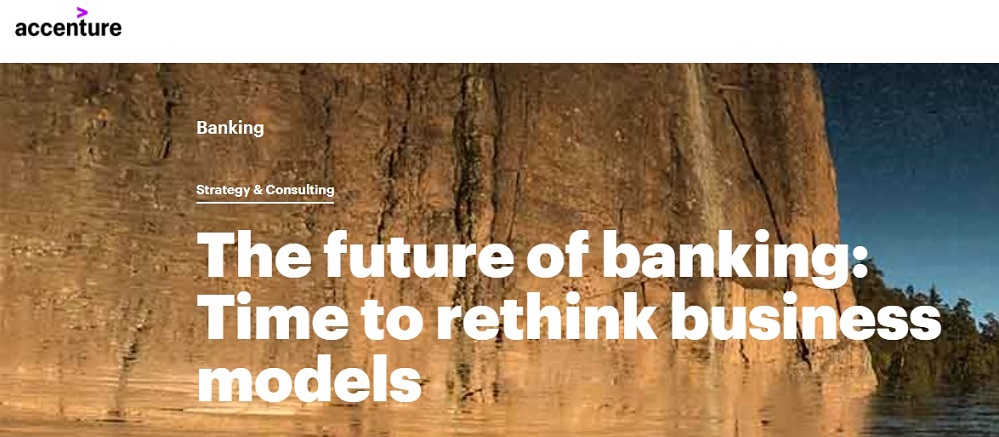
By rethinking their business models and embracing the innovative strategies of digital-only banking and financial services new entrants, traditional banks could boost revenues by nearly 4% annually, resulting in more than half a trillion dollars in additional revenues by 2025, according to a new report from Accenture.
The report, The Future of Banking: It’s time for a change of perspective,” analyzes the business models of nearly 100 leading traditional banks and over 200 digital-only players in 11 countries across North America, Europe, Asia-Pacific, and Latin America and the role they play in the banking value chain. It identified two common business models:
. vertically integrated — traditional, linear business models, i.e., those that sell only their own products, those that distribute products from other providers, and those that deliver technology or business processes to others; and
. non-linear — adaptive business models, i.e., “packagers” that assemble new propositions, adding value beyond just distribution; and firms that embed their propositions into third-party services, such as “buy now, pay later” services embedded into the merchant point-of-sale.
Many of the leading banks analyzed in the report have vertically integrated business models. However, the report found those that unbundle their traditional products and partner with third parties to create and distribute new personalized customer offerings can potentially achieve breakout growth and higher market valuations. Specifically, by layering non-linear business models on top of the traditional vertically integrated model, they could boost their annual growth rates by up to an additional 3.8%, which would result in US$518 billion in total additional revenues by 2025.

“On the surface, the banking industry appears healthy, with big banks posting robust revenues and profits,” said Michael Abbott, a senior managing director at Accenture who leads its Banking industry group globally. “But a closer look reveals that the combination of low interest rates, fee compression from increased competition, and undifferentiated product offerings is slowly eroding banks’ share of gross domestic product. And in many markets, banking and payments revenues are flowing from incumbents to new entrants. To re-ignite growth, traditional banks need to reimagine how they create and deliver compelling products that focus on customers’ intentions. That will require rethinking their vertically integrated business models.”
The report notes that between 2018 and 2020, digital-only players performed significantly better than traditional banks. But those that adopted non-linear business models achieved 76% compound annual growth rate (CAGR) in revenue, while those digital players simply emulating traditional, vertically integrated models achieved only 44% CAGR. Traditional banks in even the best-performing mature markets grew revenue at an average rate of less than 2% annually – albeit off a much larger base.
The report lists ways that traditional banks can leverage their strengths — their balance sheet power, risk management expertise, and regulatory savvy — to increase business model flexibility and differentiate themselves from the competition. Specifically, they should consider embracing one or a mix of the following models:
. Sell only products that the bank produces and control all layers in the value chain, from manufacturing to distribution, with a key value driver being the ability to consolidate via M&A and take market share.
. Build a distribution-driven ecosystem, distributing banking and financial products from other companies, and create a marketplace to distribute non-banking products.
. Seek scale by delivering technology or business processes to other companies.
. Create new propositions by building or bundling fragmented products and services, which can be distributed by the bank or third parties.
“Being digital is no longer a differentiator,” said Dilnisin Bayel, a managing director in Accenture’s Strategy & Consulting group in the U.K. “To capture growth, traditional banks need to go beyond becoming the best digital versions of themselves and become adept at operating multiple business models simultaneously. This will require that they shift their perspective to consider adaptive models that put product innovation, embedded distribution, purpose, and sustainability at the forefront. Banks can choose to continue to innovate at their current pace or take a fast-follower or leader approach to business model transformation — but they can’t afford to remain stagnant.”
The full report can be found here.
Methodology
The report, “The Future of Banking: It’s time for a change of perspective,” is based on quantitative and qualitative analysis of the business models of nearly 100 leading incumbent banks (by size of total assets) and more than 210 new banking and financial services entrants (defined by valuation, funding, and revenues) in 11 countries, including Australia, Brazil, Canada, China, France, Germany, Italy, Spain, the United Arab Emirates, the U.S. and the U.K. The analysis was complemented with data from the 2020 Accenture Banking Consumer Study and interviews with banks, digital financial services providers, industry analysts and investors.
Banking 4.0 – „how was the experience for you”
„So many people are coming here to Bucharest, people that I see and interact on linkedin and now I get the change to meet them in person. It was like being to the Football World Cup but this was the World Cup on linkedin in payments and open banking.”
Many more interesting quotes in the video below: